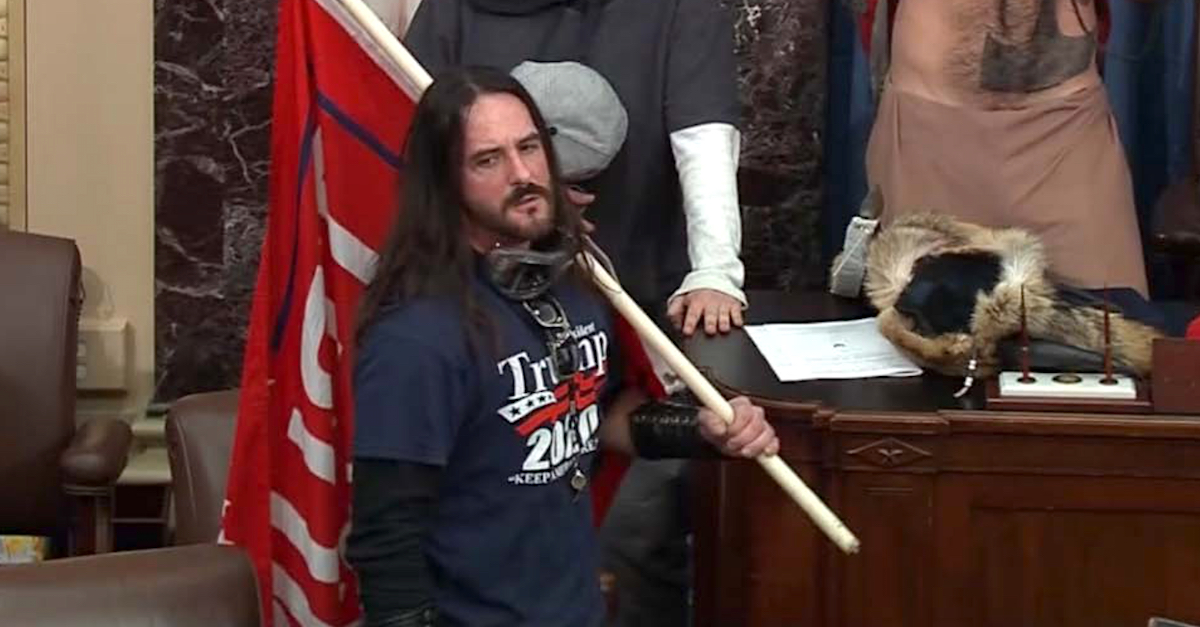
Capitol siege defendant Paul Hodgkins was captured on surveillance video inside the U.S. Senate Chamber on January 6, 2021. To the right, “Qanon Shaman” Jacob Chansley is partially visible in the frame.
A Florida man who wore a navy blue “Trump 2020” shirt while he carried a Donald Trump flag inside the U.S. Capitol Complex on Jan. 6 in Washington, D.C., on Wednesday pleaded guilty to the single most serious federal crime he faced in a five-count indictment.
According to court records, Paul Hodgkins, 38, of Tampa, entered the plea in U.S. District Court for the District of Columbia before Judge Randolph D. Moss. The judge agreed to a defense request for an “expedited” pre-sentence investigation report and scheduled a sentencing on July 19 at 10:00 a.m.
“Hodgkins pleaded guilty to one count of obstructing an official proceeding, which carries a maximum sentence of 20 years in prison, fine of $250,000 or twice the monetary gain or loss of the offense,” federal prosecutors said in a press release. “A federal district court judge will determine any sentence after considering the U.S. Sentencing Guidelines and other statutory factors.”
NPR noted that it’s more likely the defendant will serve 15 to 21 months behind bars.
Prosecutors described Hodgkins’ transgressions this way in a press release announcing the plea deal:
[Hodgkins] entered the U.S. Capitol building at approximately 2:50 p.m. on Jan. 6. Around 3 p.m., Hodgkins entered the Senate chamber, walked among the desks, and then removed eye goggles. He took a “selfie-style” photograph with his cell phone and walked down the Senate well where, a few feet away, several individuals were shouting, praying and cheering using a bullhorn. Hodgkins walked toward the individuals and remained standing with them while they continued commanding the attention of others. At approximately 3:15 p.m., Hodgkins exited the Senate chamber and the U.S. Capitol Building.
Federal court records say Hodgkins admitted he was in the Capitol when questioned by the FBI but denied knowing the others who were around him:
According to HODGKINS, he saw other people around him breaking windows, individuals engaged in a knife fight, and other injured individuals, but HODGKINS did not know those individuals or participate in the conduct. Agents showed HODGKINS two photographs, the first photograph was the “selfie”-style photo of him in the Senate well, which was obtained from [a confidential witness]. The second photograph was another photo of HODGKINS on the Senate floor. HODGKINS admitted to the interviewing agents as being the person in the photographs.
Hodgkins remains out of jail on a personal recognizance bond. He is subject to location monitoring, court records indicate.
Prosecutors originally charged Hodgkins with three counts:
(1) Obstructing or Impeding Any Official Proceeding and Aiding and Abetting;
(2) Knowingly Entering or Remaining in any Restricted Building or Grounds Without Lawful Authority and Impeding or Disrupting Official Functions; and
(3) Violent Entry and Disorderly Conduct in Capitol Buildings.
A grand jury indicted Hodgkins with additional counts:
(1) Obstruction of an Official Proceeding and Aiding and Abetting;
(2) Entering and Remaining in a Restricted Building or Grounds;
(3) Disorderly and Disruptive Conduct in a Restricted Building or Grounds;
(4) Disorderly Conduct in a Capitol Building; and
(5) Parading, Demonstrating, or Picketing in a Capitol Building.
The deal allowed the defendant to evade four criminal charges and allowed prosecutors to secure a conviction on the count which carries the most significant possible sentence.
The fourth and fifth counts of the indictment were punishable by a fine and up to six months in jail; the second and third counts of the indictment were punishable by a fine and up to a year in jail.
Hodgkins was not alleged to have used a weapon. Had he done so, and had he been so accused, the punishment would have been much more severe in a situation like this — where prosecutors agreed to dismiss certain counts in return for a guilty plea on the top charge.
Read the relevant charging documents below, which contain a photographic record of the defendant’s now-admitted movements through the Capitol:
[image via the FBI by way of federal court documents]